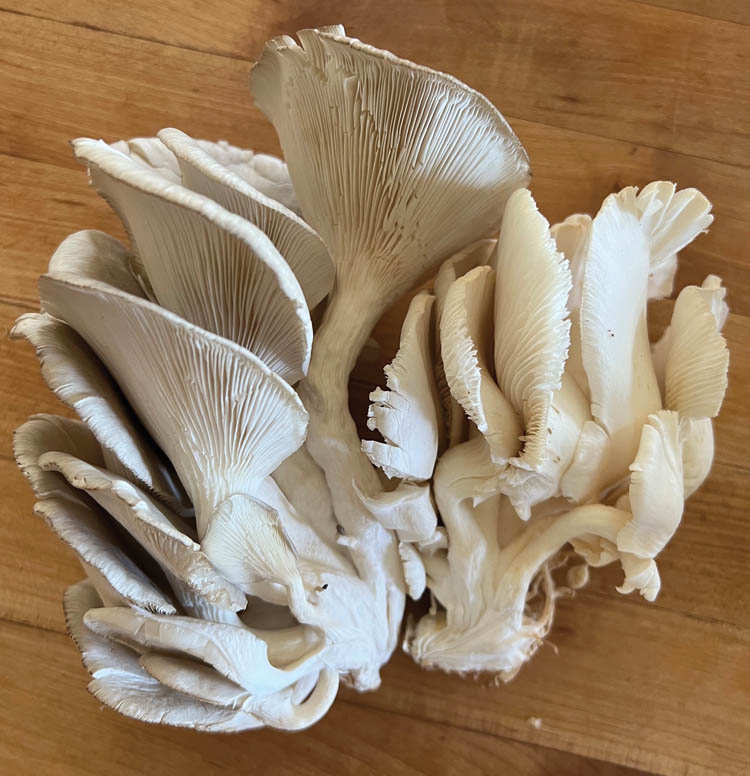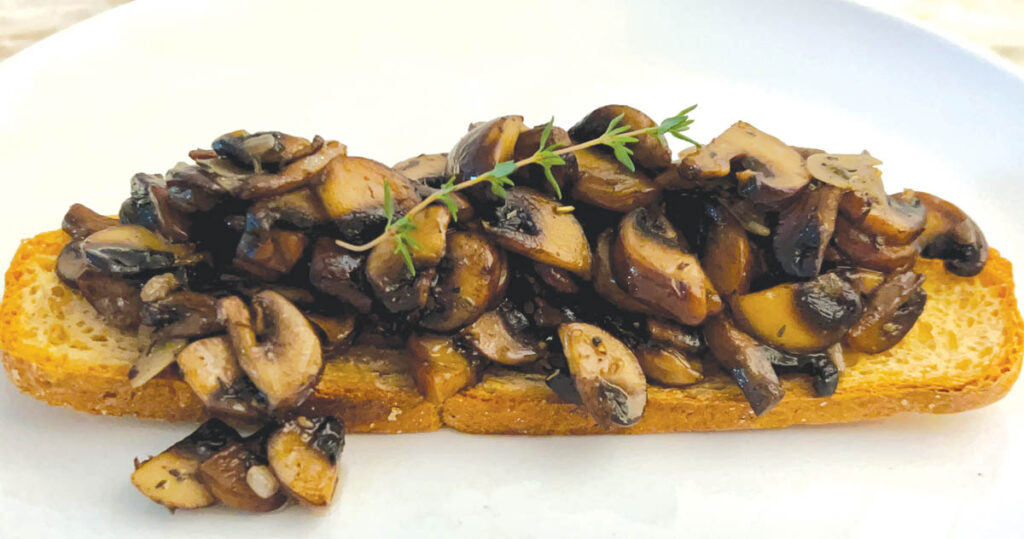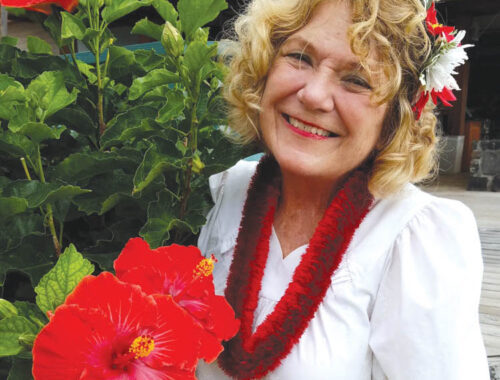
Local Food: Magic of Mushrooms, and a Recipe for Mushroom Toast

By Brittany P. Anderson
A newly fallen tree haphazardly leans against another, joining its fallen brethren to succumb to the weather and rot. The elder tree lays quietly adorned with rounded shelves of golden orange. These brightly colored frills are none other than the chicken of the woods mushroom.
Chicken of the woods, Laetiporus surphureus, is one of several edible mushrooms found on Hawai‘i Island. The wide and flat fungi grow along the base of decaying trees. These heavy, meaty mushrooms are easily spotted with their showy orange color against a backdrop of brown and green.
On decaying relics of a kukui nut orchard, the forgotten trees grow pepeiao, also known as wood ear mushrooms. Pepeiao, Auricularia cornea, grows in clusters on rotting broadleaf trees. To the touch, these mushrooms are elastic yet jelly-like and look remarkably like an ear, as their name suggests. Hawai‘i Island’s fungophiles troll the island’s forests and trails, looking for delectable wild fungi.
Trekking through switchbacks along a densely forested gulch deep in the heart of the Hāmākua coast, a couple works together collecting white wood ear. As leaves dance overhead in the fine rain, the snow-white ruffly white wood ear, Tremella fuciformis, clings to the sides of trees along the path. They gently pry the gelatinous mushrooms, with a seaweed-like texture, from their perches.
Many of the world’s cultures have used mushrooms for medicinal and culinary purposes. In Chinese medicine, wood ear is used for treating various ailments, including improving blood circulation. Today, white wood ear is used as an ingredient in cosmetics for its anti-aging properties. Mushrooms are also common ingredients in soups and stir fry, where they offer flavor and texture.
There is an inherent risk associated with foraging for wild mushrooms. Hence, proper identification is key to avoiding accidental poisoning, illness, or hallucinations. Instead of foraging, cultivating edible mushrooms has risen in popularity on Hawai‘i Island.

While combining mushroom spores and dead wood seems like an easy enough recipe for growing mushrooms, the simplicity is deceiving. Mushroom cultivation is a careful balance of temperature, humidity, and sterility.
Mushrooms are grown in sterilized sawdust as a growing medium and kept in a highly controlled environment. Less like a farm and more like a laboratory, commercial mushroom growers must keep bacteria from taking hold.
In an unregulated environment, there are millions of bacterial spores, and each one has the potential to compete with the mushroom culture. Growers use extreme caution to disinfect all tools, surfaces, and body parts that may come near their growing mushrooms.
Within the laboratory-like setting, it is also essential that those working in this environment wear respirators. An anti-aerosol respirator protects against inhaling mushroom spores, which can cause respiratory issues, and introducing bacteria into the growing room.
Hawai‘i Island home growers can find mushroom kits made locally using a 5-gallon bucket and don’t require stringent climate control. Some have even found success in inoculating logs with their desired mushroom culture.
Luckily, you don’t have to forage or grow your mushrooms on Hawai‘i Island. Several local growers offer a variety of beautiful and delicious mushrooms, from the highly medicinal lion’s mane to elegant pink oyster mushrooms.
This Mushroom Toast recipe highlights mushrooms’ flavor and can be made with one type or a medley of your favorite fungi.
Mushroom Toast
2 Tbs unsalted butter
8 oz mushrooms, ends trimmed and sliced into even pieces
3 cloves garlic, smashed
3 large sprigs of thyme
½ shallot, finely minced, about 2 Tbs
Sea salt
Freshly ground black pepper
1 tsp sherry vinegar
3 Tbs crème fraiche
Heat a large skillet over medium-high heat and melt butter. Once melted, add mushrooms (do not overcrowd the pan), garlic, and thyme. Occasionally toss until mushrooms are light brown and tender. Add shallots, season with salt and pepper, and sauté for 1–2 minutes, until shallots are tender and fragrant. Discard garlic and thyme. Add sherry vinegar and the crème fraiche. Stir to combine. Reduce heat to medium-low and let simmer all together for a moment. Taste and adjust seasoning before removing from heat. Place a few generous spoonfuls of mushrooms and sauce on top of toasted bread.
Serving suggestion: top with arugula leaves and poached egg.



